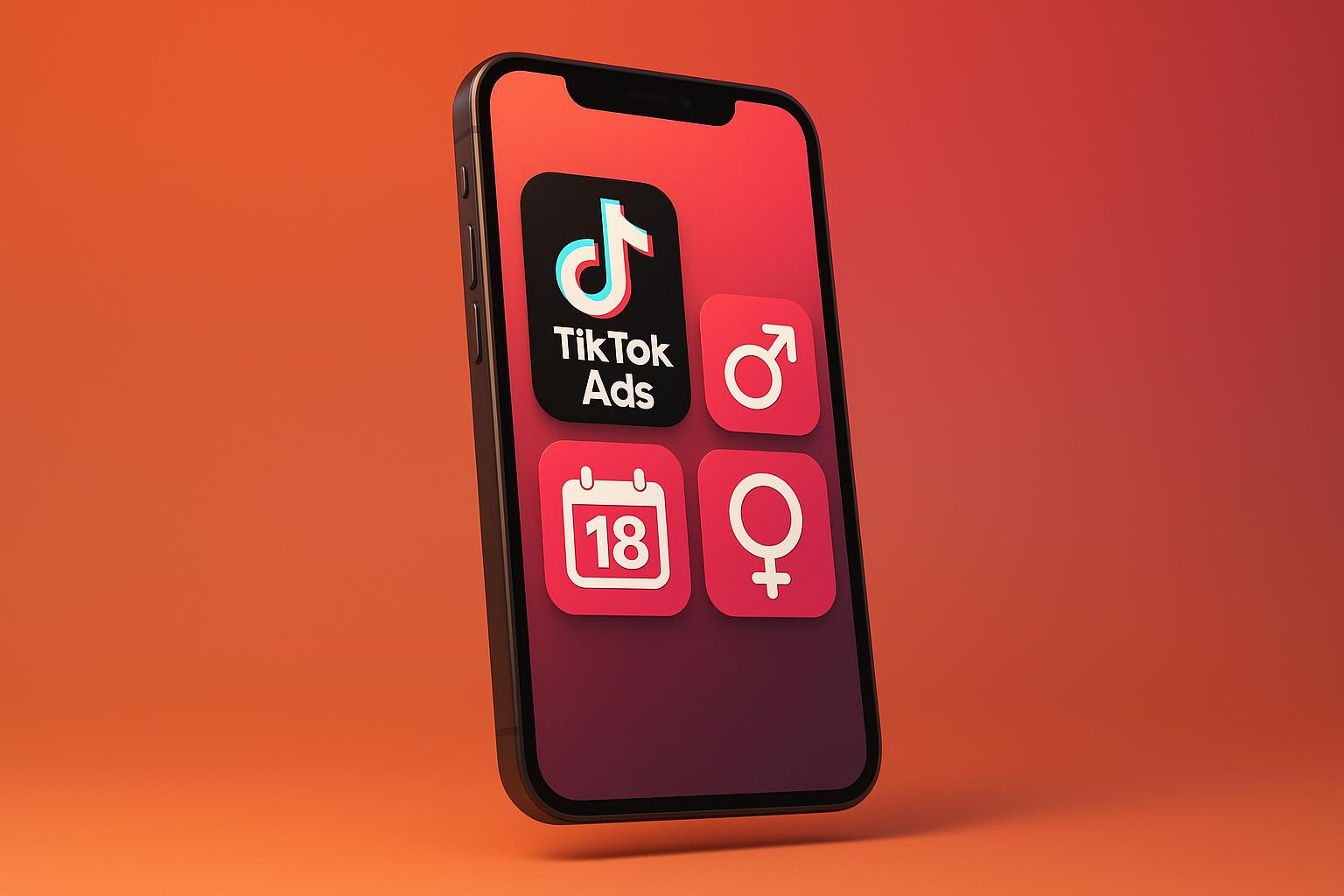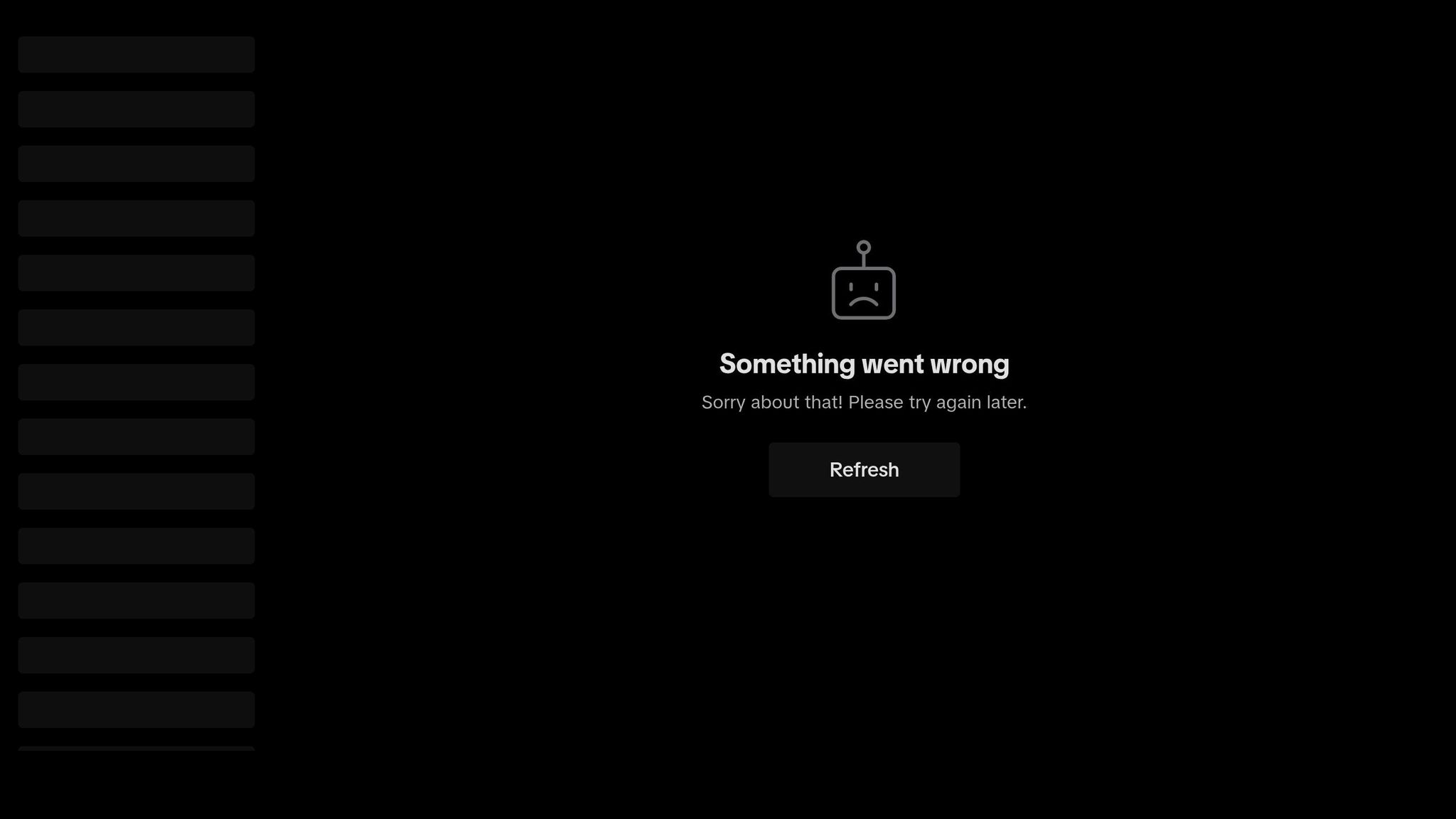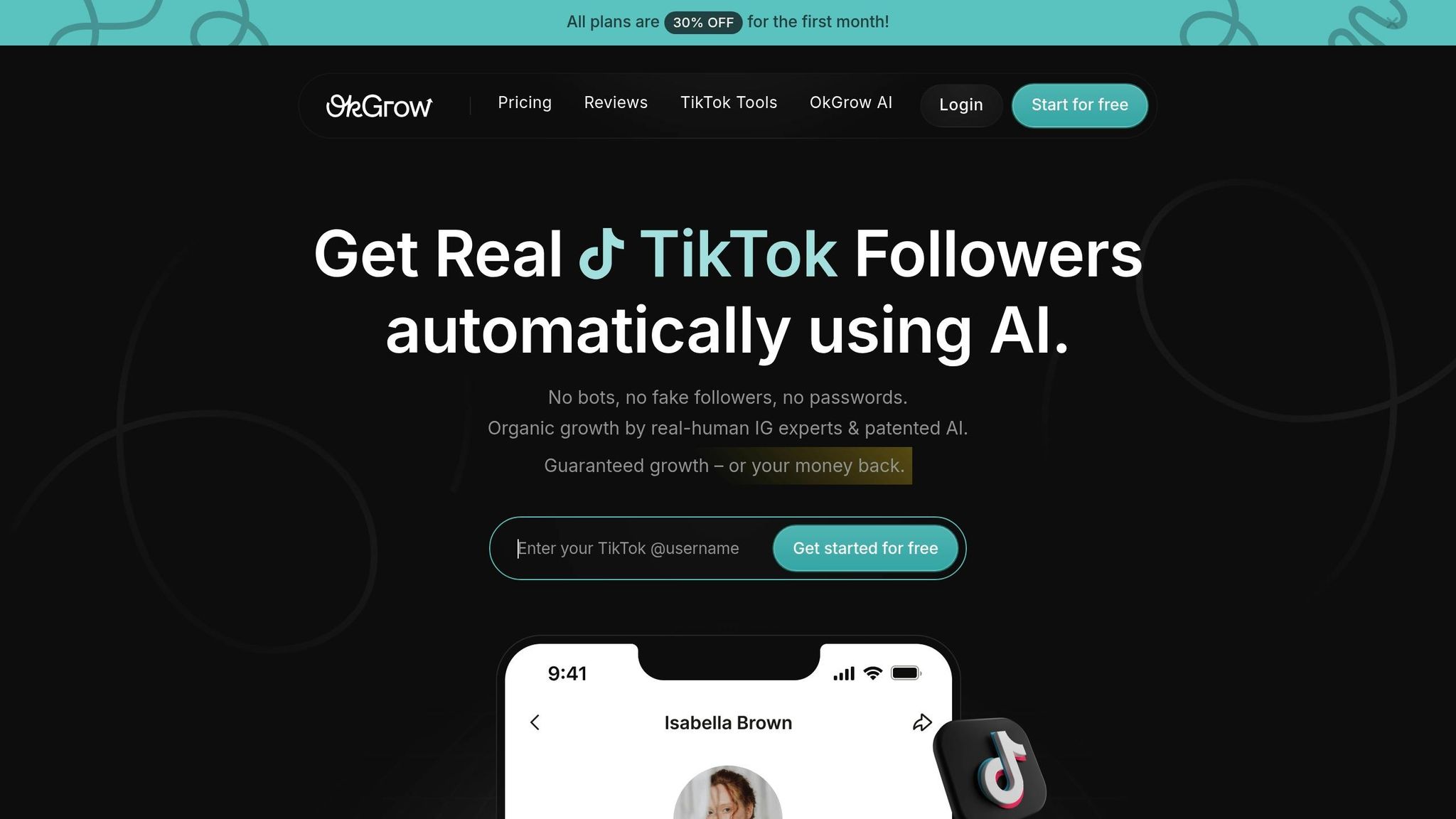7 Best TikTok Analytics Tools for Content Creators
Explore the top TikTok analytics tools to optimize content strategies, track performance, and understand audience engagement effectively.
Explore how age and gender filters on TikTok can enhance ad targeting, improve engagement, and optimize campaign results.



TikTok's targeting tools, specifically age and gender filters, allow advertisers to reach the most relevant audiences. Here's the core takeaway:
The best results come from combining age and gender filters with other targeting options like interests and behaviors. This layered approach ensures campaigns reach the right audience while avoiding wasted ad spend.
Quick Tip: Tools like OkGrow enhance TikTok's native filters with AI-driven insights, helping refine audience targeting and improve engagement.

TikTok's age filtering system is built around six preset age brackets: 13–17, 18–24, 25–34, 35–44, 45–54, and 55+. Advertisers can select one or more of these brackets to target specific audiences. However, ads targeting users under 18 are prohibited, which means certain products and services cannot be marketed to the 13–17 age group. Once age ranges are chosen, TikTok’s algorithm prioritizes delivery to those users, though some overlap might occur due to engagement patterns. This targeting feature plays a key role in refining your campaign strategy, helping you connect with the most relevant audience while improving overall results.
Age filters shine when your product or service appeals to a specific life stage or generation. They’re particularly useful for brands offering age-restricted products or services. For example, beauty brands often use age filters to reach younger demographics, while fashion retailers might target different age groups with specific apparel lines. Similarly, gaming companies and entertainment brands can focus on audiences most likely to engage with their content. By narrowing your audience to the most relevant age group, you can maximize the impact of your campaigns.
Age filters come with clear advantages. They allow for precise targeting, which helps you reach the most engaged users. This often translates to better engagement rates and higher conversion metrics. By filtering out irrelevant age groups, you can also save on ad spend and make your budget work harder. Plus, for industries with strict regulations - like those that prohibit marketing to minors - age filters are an essential tool for staying compliant.
That said, there are some downsides. Overly narrow targeting could exclude potential customers who might still find your product or service appealing, limiting your campaign’s reach and potential to go viral. Additionally, because targeting relies on user-provided data and algorithmic predictions, inaccuracies can occur. This means your ads could sometimes reach unintended age groups, diluting the precision of your targeting. Lastly, TikTok’s algorithm might occasionally expand delivery beyond the selected age ranges, which could impact your campaign’s focus.
Next, we’ll explore how gender filters stack up in terms of effectiveness.
TikTok's Ads Manager allows advertisers to target two gender categories: Male and Female. The platform identifies a user's gender based on the information they provide during account signup or by analyzing their activity patterns. To make your targeting even more precise, you can combine gender filters with other options like age or interests. With TikTok's global user base consisting of about 55.7% male and 44.3% female users, gender targeting offers a substantial reach. This segmentation is particularly useful for products or services with a clear gender-specific appeal.
Gender filters are most effective when your product or service is tailored to a specific gender. For instance, companies selling beauty and makeup products often use these filters to connect with their intended audience. Similarly, clothing brands rely on gender targeting to promote apparel designed for men or women. Entertainment and gaming industries also benefit by targeting specific genders for shows, movies, games, or apps that tend to resonate more with one gender. To maximize engagement, ensure your ad creative aligns with the preferences of your target gender.
Using gender filters can make your ads more relevant by allowing you to craft content that speaks directly to specific interests, which can lead to better campaign performance.
However, there are some downsides. Over-segmenting your audience can shrink your reach, limiting ad delivery and hindering the algorithm's ability to optimize effectively. Additionally, gender targeting runs the risk of reinforcing stereotypes or excluding individuals who don't fit into traditional gender categories or who have interests that cross those boundaries. The accuracy of this targeting also depends on the data users provide and TikTok's algorithmic inferences, which aren't always reliable.
Age and gender filters each shine in specific scenarios. Age filters are particularly useful for life-stage marketing, where products or services cater to specific phases of a consumer's life. For example, targeting college students for educational tools or retirees for financial planning services works well with age-specific strategies.
Gender filters, on the other hand, are ideal for products with a clear gender focus. Beauty and makeup campaigns often achieve better conversion rates with female audiences, while certain gaming apps may resonate more with male users. The key is to focus on genuine product relevance rather than relying on outdated stereotypes.
One notable distinction between the two lies in audience size. Age filters generally allow access to a broader audience across multiple age groups. In contrast, gender filters divide the audience more sharply. For instance, TikTok's user base is split at 53.3% male and 46.7% female.
Given their differences, combining age and gender filters can refine your targeting even further. Start with your primary demographic filter and then layer in the secondary one for added precision.
For consumer goods, beginning with gender targeting and then applying an age filter can pinpoint the most relevant subgroup. For example, a premium anti-aging skincare brand might focus on mid-life women, while a trendy makeup line could target younger females.
Commerce and apparel brands also benefit from this approach. A retailer specializing in men's business suits could target males in age brackets that include both young professionals and seasoned executives. Similarly, a women's activewear brand might select an age range that aligns with its core consumer base.
In gaming and entertainment, this combination can be particularly effective. A mobile strategy game might target males in a mid-adult age range, while a romantic comedy series could focus on younger female viewers.
| Aspect | Age Filters | Gender Filters |
|---|---|---|
| Audience Size | Broader reach across multiple age groups | Splits the audience nearly in half |
| Best Use Cases | Life-stage marketing (e.g., college students, retirees) | Products/services with clear gender relevance (e.g., beauty, makeup, gaming) |
| Targeting Precision | Enables age-specific messaging | Allows focused, gender-specific messaging |
| Combination Potential | Works well with other targeting options for greater refinement | Complements age filters for enhanced accuracy |
| Industry Applications | Life-stage campaigns | Campaigns with strong gender appeal |
| Restrictions | Targeting under-18 users restricted in some regions | Gender targeting for under-18 users restricted in certain regions |
The most effective campaigns often begin with one primary demographic filter, layering in additional options based on performance data. This approach allows TikTok's algorithm to optimize results while keeping your messaging relevant to your target audience.

TikTok’s built-in age and gender filters are a great starting point, but OkGrow takes targeting to a whole new level. With its AI-powered Smart Auto Targeting, OkGrow uses advanced algorithms and data insights to zero in on users who are genuinely interested in your niche. It doesn’t stop there - OkGrow combines niche targeting with location and language data, ensuring your content reaches the right audience. Plus, the platform's analytics tools let you fine-tune your strategy based on how users are engaging with your content. These features work hand-in-hand with TikTok's native filters, giving you a more precise and effective reach.
OkGrow doesn’t just stop at targeting - it helps you optimize your profile and content to boost engagement. The AI Profile Optimization tool customizes your profile to appeal to specific age and gender segments. Need content ideas? OkGrow’s viral content library offers trending suggestions tailored to your audience. And with OkGrow Boost™, you can amplify your content’s visibility - even when your niche targeting narrows the audience.
"OkGrow's AI-powered features have significantly boosted my TikTok engagement organically. I've seen a noticeable increase in likes, comments, and followers."
– Marvin McKinney, Project Manager at EightSleep
What’s more, OkGrow ensures that you gain real followers while staying fully compliant with TikTok’s guidelines.
Since 2016, OkGrow has helped over 100,000 TikTok users achieve up to 10x faster growth in real followers. With a thriving community of 58,980+ TikTokers and brands, it’s clear that OkGrow delivers results. Its AI-driven system goes beyond basic filters, analyzing behavioral patterns, interests, and engagement history to connect your content with the right audience. Need extra support? Higher-tier plans include 24/7 assistance and dedicated account managers to keep your strategy on track for sustainable, organic growth.
Age and gender filters can be powerful tools when used thoughtfully. For example, age filters are ideal if your product or service appeals strongly to specific generations - think skincare for teens or financial planning for retirees. Gender filters, on the other hand, work well when your content naturally connects with gender-specific interests. However, it’s important to apply these filters carefully to avoid excluding potential customers who might not fit traditional assumptions.
The real magic happens when you combine these demographic filters with TikTok's interest and behavioral data. Instead of using them in isolation, successful campaigns layer these filters to create a more nuanced approach. TikTok's projected ad revenue growth - from $23.6 billion in 2024 to $33.1 billion in 2025 - shows just how much advertisers trust these targeting options to deliver results.
"Age and gender targeting can be applied across various industries and use cases." - TikTok Ads Manager
The best campaigns don’t rely on rigid parameters. Instead, they use age and gender filters as a foundation, refining strategies based on performance and engagement data. This flexibility ensures you’re not excluding interested users while still targeting effectively.
To take your TikTok campaigns to the next level, don’t stop at basic demographic filters. While age and gender targeting provide a strong starting point, tools like OkGrow can help you go deeper with AI-driven audience insights and advanced targeting features.
Experiment with different combinations of age and gender filters, then analyze metrics like engagement, conversion rates, and cost per acquisition to uncover your most valuable audience segments. By tracking these performance indicators, you can fine-tune your strategy for better results.
Consider leveraging tools like OkGrow to refine your targeting further. Its features - such as niche targeting, behavioral analysis, and real-time analytics - allow you to move beyond basic demographics and connect with users who are genuinely interested in your content.
The key is to start simple, test what works, and scale up from there. Whether you’re focusing on Gen Z fashion lovers or millennial homebuyers, the right mix of demographic filters and advanced tools can help you achieve standout results on TikTok.
Combining age, gender, and interest-based filters on TikTok allows advertisers to target a highly specific audience by layering demographic details with user preferences. This means your ads are shown to users who not only fit the desired age and gender but also have a genuine interest in your product or content.
This refined targeting can help improve engagement, drive conversions, and deliver a stronger return on investment. In a diverse market like the U.S., where interests and preferences vary greatly, this strategy helps make your campaigns more relevant and effective.
Focusing only on age and gender filters for TikTok ads can seriously limit how far your campaign reaches and how well it performs. While these filters might help you target broad groups, they don’t tap into the specific interests, behaviors, or preferences that truly drive engagement.
Relying too heavily on these demographic filters can also increase your costs. Why? Because narrowing your audience too much means you could miss out on users who might actually resonate with your content. Plus, sticking to this approach might cause you to overlook more advanced targeting options - like behavioral or contextual targeting - that often do a better job of connecting you with the right audience and delivering stronger results.
OkGrow takes TikTok targeting to the next level with its AI-driven audience segmentation, offering much more than the platform's standard age and gender filters. While TikTok provides a broad approach, OkGrow leverages advanced AI to analyze real-time data and make on-the-fly adjustments. The result? Your content reaches the audience that's most relevant to your goals.
With tools like smart auto-targeting, niche-specific targeting options, and detailed analytics, OkGrow empowers creators to connect with their ideal audience more effectively. This level of precision not only enhances engagement but also drives better results for your TikTok campaigns.

